Ski: 2020-2021 DPS Alchemist Wailer 106 C2, 189 cm
Test Locations: Alyeska, AK; Telluride, CO
Days Skied: ~35
Available Lengths: 171, 179, 184, 189 cm
Blister’s Measured Tip-to-Tail Length: 187.7 cm
Blister’s Measured Weight per Ski: 2097 & 2113 grams
Stated Dimensions: 139-106-123 mm
Blister’s Measured Dimensions: 139.0-106.0-122.3 mm
Stated Sidecut Radius (all lengths): 19 meters
Measured Tip & Tail Splay (ski decambered): 61 mm / 37 mm
Measured Traditional Camber Underfoot: ~3 mm
Core: Aspen + Prepreg Carbon Fiber Laminate
Base: Sintered Race Base
Factory Recommended Mount Point: -11.25 cm from center; 82.6 cm from tail
Boots / Bindings: Lange RX 130, Head Raptor 140 RS, Dynafit Hoji Free, Scarpa Maestrale XT, Nordica Strider 120 / Tyrolia AAAttack2 13 AT
[Note: Our review was conducted on the 19/20 Wailer A106 C2, which returns unchanged for 20/21.]

Intro
A couple years back I reviewed DPS’s Wailer 106 in their Alchemist construction. I came away with pretty positive impressions, saying “For those who enjoy a carved turn whenever possible, it handles crud and chop as well or better than any ski in its weight class, and it has a very low swing weight that makes it feel quick and lively in tight spots.”
For 19/20, DPS tweaked their mid-fat all-mountain ski, but what exactly did they change?
What DPS says about the Wailer A106 C2
“The all-mountain classic is reborn with a fresh C2 Chassis. We have worked hard in the lab and on mountain to fine-tune optimum geometric ratios for sidecut and flex pattern, and the newly minted 106 reflects the most current blend of smoothness, balance, and power; in an all-mountain, everyday shape designed for mixed snow conditions.”
I think that last line has some of the key phrases: “smoothness, balance, and power” and “everyday shape designed for mixed snow conditions.” Our experience on the 18/19 Wailer A106 seems to line up with that description, but what’s all this talk about optimizing “geometric ratios for sidecut and flex pattern?”
We asked DPS to shed some light on what’s new with the 19/20 Wailer A106 C2, and they said “the tip shape is noticeably different to provide better float in pow and the flex profile was slightly tweaked to provide a smoother, more predictable overall feel with increased energy transfer between turns.”
The 18/19 Wailer A106 didn’t really stand out when it came to flotation in powder, but it did do a great job of creating lots of energy between turns, so it’ll be interesting to see if the new ski is both more energetic and floats better in fresh snow.
Shape / Rocker Profile
As we just noted, DPS tweaked the shape of the Wailer A106 for 19/20. The changes are pretty subtle, but the main difference seems to be that the 19/20 Wailer A106 C2 now has slightly longer and straighter taper lines, most notably in the tip.
The 18/19 Wailer A106 didn’t have much tip taper (especially compared to other DPS skis), but its tips and tails did taper to a point. The 19/20 Wailer A106 C2 looks like it has a bit more surface area in its tips and tails due to its straighter taper lines, which could lead to improved flotation. It’s also worth noting that our pair of the 189 cm 19/20 Wailer A106 C2 has slightly narrower tips and tails compared to our pair of the 189 cm 18/19 Wailer A106.
Overall, the new Wailer A106 C2’s shape is on the slightly “more tapered” end of the spectrum, now looking more similar to skis like the Salomon QST 106 and RMU North Shore 108 than it does to more traditionally shaped skis like the Blizzard Cochise, Black Crows Corvus, Icelantic Nomad 105, etc.
The new Wailer A106 C2’s rocker profile looks almost identical to the previous version’s, with the only discernable difference being that the new ski has slightly higher tip and tail splay, and maybe a slightly deeper tail rocker line. The 19/20 ski has 61 mm of tip splay and 37 mm of tail splay while the previous ski had 56 mm of tip splay and 27 mm of tail splay.
The Wailer A106 C2’s rocker profile is pretty standard for a modern 106mm-wide ski. There are some skis with more rocker and others with less, but there’s nothing particularly wild / odd / weird about the Wailer A106 C2’s rocker profile.
Flex Pattern
Here’s how we’d characterize the flex pattern of the 189 cm Wailer A106 C2:
Tips: 9
Shovels: 8.5-9
In Front of Toe Piece: 9-9.5
Underfoot: 10
Behind the Heel Piece: 9.5-9
Tails: 9
The 189 cm 18/19 Wailer A106 was a very strong ski, and so is the 19/20 Wailer A106 C2. The new Wailer A106 C2 is very stiff through its entire length, with no portion of the ski being close to what we’d call “soft.”
The 189 cm Wailer A106 C2’s flex pattern is pretty similar to the Prior Husume, Fischer Ranger 107Ti, Folsom Hammer, and DPS Wailer A110 C2 — all of which are very stout skis.
As we noted in our review of the 18/19 Wailer A106, we’re not confident that it’s safe to assume that all of the shorter lengths of the Wailer A106 C2 are as stiff as the 189 cm version, but all of the longer Alchemist-construction DPS skis we’ve reviewed have been quite stiff.
Weight
While not as light as their old “Pure” carbon constructions, DPS’s Alchemist-construction skis are still pretty light. The new Wailer A106 C2 is coming in a bit heavier than the 18/19 version, but it’s definitely not super heavy.
The 19/20 Wailer A106 C2 is a bit heavier than skis like the Elan Ripstick 106, Line Sick Day 104, Rossignol Soul 7 HD, etc., but it’s not nearly as heavy as metal-laminate skis like the Nordica Enforcer 104 Free, Blizzard Cochise, and J Skis Metal.
For reference, here are a number of our measured weights (per ski in grams) for some notable skis. Keep in mind the length differences to try to keep things apples-to-apples.
1755 & 1792 Line Sick Day 104, 179 cm (17/18–20/21)
1787 & 1793 Fauna Pioneer, 184 cm (19/20–20/21)
1806 & 1862 Armada Tracer 108, 180 cm (19/20–20/21)
1848 & 1903 Line Sick Day 104, 186 cm (17/18–20/21)
1849 & 1922 Elan Ripstick 106, 188 cm (17/18–19/20)
1883 & 1898 Rossignol BLACKOPS Sender, 178 cm (20/21)
1996 & 2012 Dynastar Legend X106, 188 cm (17/18–19/20)
1999 & 2020 Rossignol BLACKOPS Sender Ti, 180 cm (20/21)
2005 & 2035 Liberty Origin 106, 187 cm (19/20–20/21)
2006 & 2065 Head Kore 105, 189 cm (19/20–20/21)
2011 & 2028 Moment Wildcat 108, 184 cm (19/20)
2027 & 2052 K2 Reckoner 112, 184 cm (20/21)
2030 & 2039 Rossignol Soul 7 HD, 188 cm (17/18–19/20)
2042 & 2062 Dynastar M-Pro 99, 186 cm (20/21)
2079 & 2105 Kastle FX106 HP, 184 cm (19/20–20/21)
2097 & 2113 DPS Alchemist Wailer 106 C2, 189 cm (19/20–20/21)
2101 & 2104 Fischer Ranger 102 FR, 184 cm (18/19–20/21)
2110 & 2119 Moment Wildcat 108, 190 cm (19/20)
2112 & 2125 4FRNT MSP 107, 187 cm (18/19–20/21)
2120 & 2134 Blizzard Rustler 10, 188 cm (19/20–20/21)
2143 & 2194 ON3P Wrenegade 108, 184 cm (18/19–19/20)
2153 & 2184 Rossignol BLACKOPS Sender Ti, 187 cm (20/21)
2165 & 2211 K2 Mindbender 108Ti, 186 cm (19/20–20/21)
2165 & 2219 Icelantic Nomad 105, 191 cm (19/20–20/21)
2170 & 2180 Dynastar M-Free 108, 182 cm (20/21)
2177 & 2180 Moment Commander 108, 188 cm (19/20)
2182 & 2218 Nordica Enforcer 110 Free, 185 cm (17/18–20/21)
2188 & 2190 Prior Northwest 110, 190 cm (19/20–20/21)
2190 & 2268 Armada ARV 106Ti LTD, 188 cm (18/19–19/20)
2202 & 2209 Shaggy’s Ahmeek 105, 186 cm (19/20)
2218 & 2244 Volkl Mantra 102, 184 cm (19/20–20/21)
2232 & 2242 Blizzard Cochise 106, 185 cm (20/21)
2232 & 2244 ON3P Woodsman 108, 187 cm (19/20)
2233 & 2255 Nordica Enforcer 104 Free, 186 cm (19/20–20/21)
2250 & 2307 Argent Badger, 184 cm (19/20)
2283 & 2290 ON3P Wrenegade 108, 189 cm (18/19–19/20)
2312 & 2386 Prior Husume, 188 cm (17/18–20/21)
2318 & 2341 J Skis The Metal, 186 cm (16/17–19/20)
2321 & 2335 Fischer Ranger 107 Ti, 189 cm (19/20–20/21)
2325 & 2352 Folsom Blister Pro 104, 186 cm (19/20)
2376 & 2393 Blizzard Cochise, 185 cm (15/16–19/20)
Bottom Line (For Now)
The updated DPS Alchemist Wailer 106 C2 isn’t drastically different compared to the previous version — it’s still very strong, has a moderate amount of rocker, and sits around the middle of the spectrum when it comes to weight. But the new ski’s shape looks like it could make it a bit more maneuverable and less carving-oriented, and we’ll soon be posting updates regarding its on-snow performance.
FULL REVIEW
I’ve now spent a good chunk of time on the current iteration of the Wailer A106 C2 at my home resort of Alyeska, and Luke Koppa and Jonathan Ellsworth also got on it for a bit last season. Jonathan provided his take on the ski in our 19/20 Winter Buyer’s Guide, and I definitely agree with him. But now we’re diving into more detail, so here’s our take on the Wailer A106 C2’s overall performance, as well as how it compares to the old version.
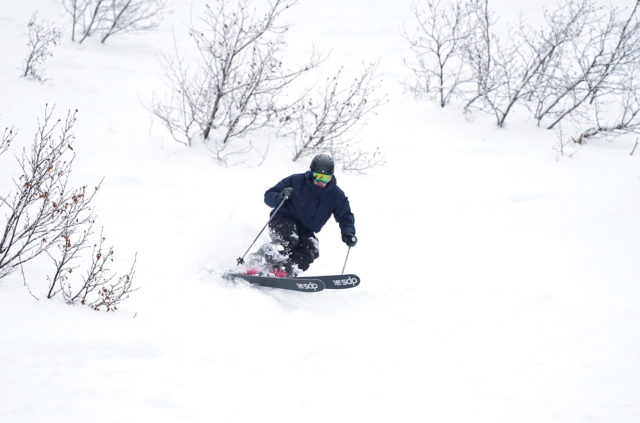
Groomers
Paul Forward (6’, 190 lbs): In my review of the previous Wailer A106 I mentioned multiple times how good they were at carving a clean turn on groomers. The new Wailer A106 C2 shares a similar mount point (-10.4 cm on the old vs. -11.25 cm on the new version) and sidecut radius (18 m on old vs 19 m on new) and both utilize DPS’s Alchemist construction. The primary difference upon inspection of the new C2 version of the 106 is its slightly deeper tail rocker line and slightly more tapered tip.
On groomers, the 18/19 Wailer A106’s tips engage early in the turn and pull the ski across the fall line better than just about any ski in this waist width I’ve used. I really enjoyed that version on soft groomers for this reason and was able to start bending the ski into a powerful carve very early in the initiation of a turn. The new Wailer A106 C2 has a different rocker profile and a more tapered tip that is more reluctant to engage across the top of the turn. Once on edge, the new Wailer A106 C2 still holds a carve quite well but it seems to respond best to a slightly more neutral stance than the old Wailer A106, which really snapped around when driving the tips.
Finishing the turn is also a bit different with the new Wailer A106 C2 than the old one. The tails of the newer C2 version have slightly deeper rocker lines and don’t provide quite the snap and drive of the older version with it’s flatter, lower tail.
Overall, the new Wailer A106 C2 is still a fun ski for carving groomers but they’re not quite as standout in this regard as the previous version.
Luke Koppa (5’8”, 155 lbs): I only spent a couple of days on the Wailer A106, but I agree with everything that Paul has said. I didn’t ski the previous version of the Wailer A106, but I think the new version is a pretty solid carver for its width. Not exceptional, but pretty easy to get on edge and good edge hold for its width. And at very high speeds when I was actually able to really bend the very stiff 189 cm version, it produced a good bit of energy coming out of a turn.
Chop / Crud
Paul: We’ve noted in previous reviews that DPS’s Alchemist construction is a nice step forward in the brand’s ambition to create skis that are relatively light but still have some degree of damping that wasn’t previously associated with carbon-construction skis. In this regard, the Wailer A106 C2 is pretty comparable to other Alchemist skis. Combine the 189 cm version’s >2000 g mass with its fairly stiff flex through the tips and the Wailer A106 C2 can hold its own in chop. It seems to prefer a more active and lighter touch when skiing really fast but it also performs pretty well for its weight when just riding the edges and trying to knife through rough, deep chop.
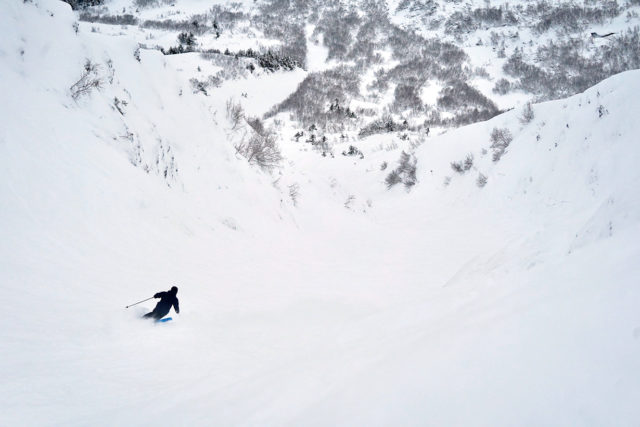
This continues to hold true as the chop gets shallower. During a refreshingly cold period of weather in late January, Alyeska served up top-to-bottom firm but fun chalky conditions with the occasional deeper refresh of unusually low-density and cold snow. In these conditions, the Wailer A106 C2 worked great as it held a nice edge but also felt quick and nimble when needed. During our more recent warmer storms, I’ve been favoring wider and heavier skis — the runs I got out on the Wailer A106 C2 reminded me that they are still fairly light, stiff carbon skis and in the very firm and dense chop / crud, they transmit a lot more feedback than heavier metal-laminate skis I’ve compared them to.
In comparison to the 18/19 Wailer A106, I have mixed feelings about the new Wailer A106 C2 when it comes to performance in variable snow. On one hand, the older ski was easier to engage and rail a carved turn in just about any conditions. The 18/19 shape also provides a longer effective edge and I’d say its suspension / damping is just slightly better. On the other hand, the revised rocker lines and tip shape of the new Wailer A16 C2 make it a little surfier and easier to skid around and shut down quickly. So the winner between the two versions will likely come down to how you approach variable conditions. If you love to just carve and slice through them, you’d likely prefer the old version. If you want to be able to skid and slarve through these conditions, you’ll probably like the new version.
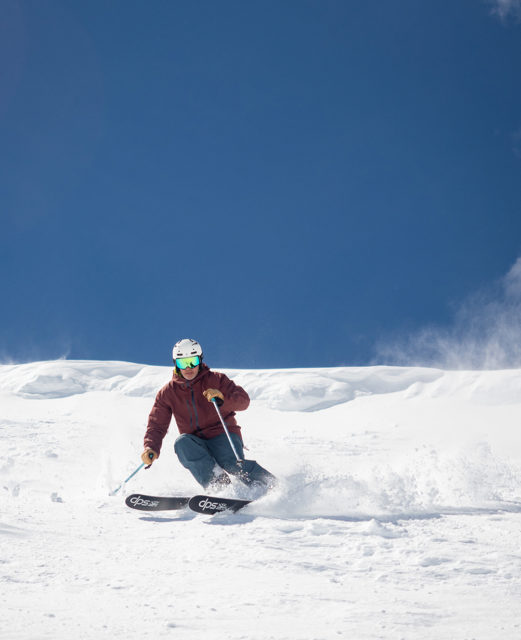
Luke: Yep. I think the Wailer A106 C2 is pretty stable for its weight, and I’d say it definitely shines in low-density chop. Because it’s so stiff, if I stayed on top of its shovels, I could ski quite hard on it in light, dry chop where it could cut right through the snow. In denser, more consolidated chop and crud, I found myself skiing slower and paying more attention to my line choices since the ski would not just blow through the set-up snow. It wouldn’t be my top pick for skiing hard through crud, but no ~2000-g ski would be. But I did like that the Wailer A106 C2 was fairly easy to shut down, which I think is a necessity for skis that are this light and therefore require a more active skiing style in variable conditions. I don’t want to be locked into a Super G turn on a lightweight ski that gets knocked around at high speeds, and I never felt like I had to worry about that on the Wailer A106 C2.
Moguls, Trees and Tight Terrain
Paul: Similar to my experience in chop and crud, the newer Wailer A 106 C2 feels a little easier to skid and smear around in tight spaces than the old one, despite having a slightly more rearward mount point and being a bit heavier. While the light(ish) weight of the Wailer A106 C2 is a bit of a liability when skiing fast in crud and chop, it’s more of a boon when quick, precise turns are needed in tight spaces.
Alyeska recently opened a section of steep — and in places — fairly tight tree skiing that has recently become pretty moguled out. The other day I found myself chasing a former Olympic mogul skier through there. While I certainly couldn’t match him turn for turn, I was able to keep up and I think a lot of that is due to the fact that I was on a fairly nimble ski that still has supportive enough tails so that I could comfortably get back to a proper, forward stance when I got bucked off balance.
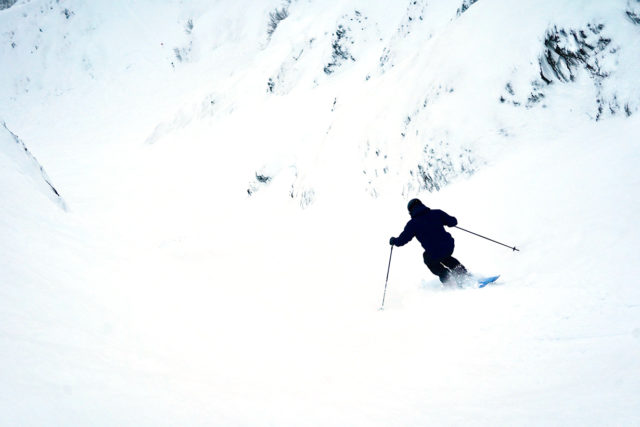
While it’s not the absolute loosest or most forgiving ski (its tail is still quite stiff), for technically proficient skiers, the Wailer A106 C2 can be skied very quickly and aggressively in tight terrain.
Luke: At my size (5’8”, 155 lbs), the 189 cm Wailer A106 C2 feels like a pretty big ski in tight spots, though I did like it in the more open, widely spaced moguls of Telluride last year. For a place like Crested Butte, with lots of very tight, techy terrain, I’d certainly prefer the 184 cm version. But in moderately spaced bumps and trees, the 189 cm Wailer A106 C2 felt pretty quick and manageable.
As someone who tends to prefer skis with more forward mount points and softer, rockered tails, the Wailer A106 C2 required me to ski it with more of a forward stance than I’d typically use, but I wouldn’t call it super punishing. I think part of this comes down to its flex pattern — while this is a very stiff ski, its consistently stiff, and I found it easier to stay over the front and in control than some skis with super stiff tails and really soft shovels (the Wailer A106 C2 felt similar in this regard vs. the DPS Foundation Koala 119 and Alchemist Wailer 110 C2, which are also very consistently stiff skis).
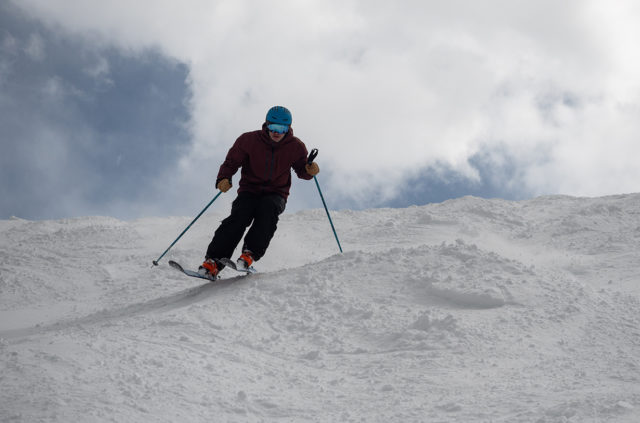
I wouldn’t recommend the Wailer A106 C2 to beginners or intermediates who are prone to backseat skiing when the terrain gets tight, but I think most advanced and expert skiers would be fine on it. As long as you stay out of the backseat, the 189 cm Wailer A106 C2 feels pretty quick (especially for its size).
Powder
Paul: A lot of people in a lot of places are going to expect their ~105mm-wide ski to serve as a reasonable powder ski and I think that the changes DPS made with the new Wailer A106 C2 have overall facilitated improved powder performance.
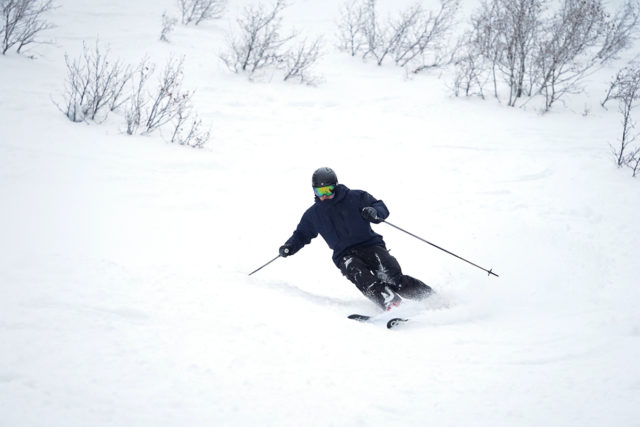
The increased tail rocker and more tapered tip of the C2 version make the ski noticeably surfier and loose in untracked powder than the older version. I still much prefer a fatter or a more powder-specific shape in deep snow, if given the option, but for first tracks on a powder day at the hill or ski-touring laps, the Wailer A106 C2 provides a fun ride with adequate float for most days. The more rearward mount point definitely biases it more toward directional, down the fall-line powder skiing vs a surfier and slarvy ride, but it’s still possible to roll the ankles and make the ski drift across the fall line on even moderately steep slopes.
For reference, the ~106mm-wide ski that I hold in high regard as a powder ski is the old 16/17–17/18 Salomon QST 106. In comparison, the Wailer A106 C2 felt much more directional, offered less float, and was significantly harder to throw sideways. That said, the QST does not feel as good to me in a firm-snow carved turn, so there’s the tradeoff.
In the low-density, cold pow we had last month the Wailer A106 C2 felt pretty good for fast laps down Alyeska’s north face. Once the temps rose a bit and the snow got a little heavier or wind affected, I definitely would have preferred more floatation, and whenever tracks were encountered, I was reminded that I was still on a fairly light carbon ski that is more prone to getting knocked around than heavier, more damp options.
Playfulness
Paul: The weight and shape of the C2 106 suggest a ski that would be fairly playful but the -11 cm mount point definitely makes them feel less likely to want to jib around on the hill. That said, I haven’t thrown a 360 all season and lately my “tricks” max out at shifties so I’m not the best judge of skis in regard. It does feel looser and a little easier to throw around than its slightly more traditionally shaped Wailer 106 predecessor.
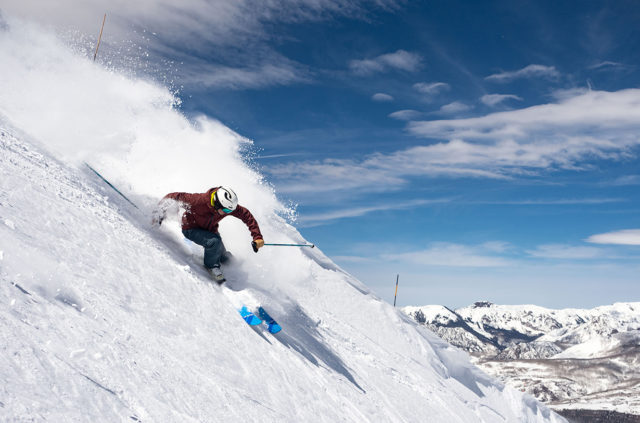
Luke: Yeah, this certainly does not feel like a freestyle-oriented ski, but its low weight and fairly loose feel do add to its playfulness compared to other directional options. Directional skiers coming from much heavier, less tapered, and less rockered skis will find this ski to feel more lively and nimble, and thus more playful. But if you tend to prefer skis with more forward mount points (around -7 cm or closer to center), this ski probably won’t feel very playful. It’s really stiff throughout, it’s not super loose compared to most twin-tipped freestyle skis in this width, and while it has a fairly low swing weight, I wouldn’t say it feels very balanced in the air.
Length
Paul: I recently had a conversation with Jonathan Ellsworth about how I’ve recently found myself gravitating more toward ~185 cm skis in the 105 mm and skinnier widths as opposed to my long-time preference for 190+ cm lengths for pretty much everything. I’ve found that particularly true in a few of the heavy Volkl skis I’ve recently skied, like the Mantra 102 and Mantra M5, in which I prefer the 184 cm lengths rather than the 191 cm.
In contrast to that, I never doubted for a second that the 189 cm Wailer A106 C2 is the size for me. The Wailer A106 C2 feels quite easy to ski overall and during my brief experiences with the previous 185 cm Foundation Wailer 106, it felt quite short, twitchy and definitely much too short for me. If you’re between sizes, I wouldn’t worry too much about sizing up on these.
Luke: I’m a notably smaller guy than Paul and almost always prefer skis in this width in the 183-187 cm length range, so the 189 cm Wailer A106 C2 is longer than I’d typically choose for a ski in this class. I think for all but the most open terrain, I’d prefer the 184 cm version of this ski.
At my size (again, 5’8”, 155 lbs), the 189 cm Wailer A106 C2 felt pretty long and cumbersome in very tight terrain. Its swing weight is pretty low for its size, but there’s still a lot of ski (especially in front of your boots). Since I ski a lot of tight terrain at Crested Butte, I think I’d be happy trading a bit of high-speed stability for a more manageable experience in tight terrain. With all that said, I think Paul’s right in that, if you are between sizes, going up a size wouldn’t be a huge deal. The 184 cm Wailer A106 C2 would’ve been my first choice to begin with, so I’m not surprised the 189 cm version felt a bit long.
Who’s It For?
Paul: I think the skiers who will most appreciate the Wailer A106 C2 are those looking for a fairly light, directional ski that can take on just about anything a day on the hill or out touring throws at them. In addition, anyone who loves the way DPS Alchemist skis ride in general will likely be a big fan, since the new Wailer A106 C2 shares a lot of performance traits with other Alchemist skis in the line (particularly when it comes to damping / suspension). Finally, if you really liked the previous Alchemist Wailer 106 but want something a little more maneuverable and better in fresh snow, the new C2 version is probably a great choice.
Luke: Yep, if I had to pick the key points from Paul’s description they’d be “directional” “fairly light” and “anything a day throws at them.” The Wailer A106 C2 is a versatile ski when it comes to terrain and conditions, and it will best reward skiers with fairly good technique who prioritize quickness over high-speed stability and damping. And I think it’d be particularly appealing for those who want to use this setup in the resort and in the backcountry.
This is not a freestyle ski, nor is it a very damp charger, nor is it a super forgiving ski for beginners. But if you prefer fairly light skis that are strong enough to be skied aggressively with an active style, the Wailer A106 C2 makes a lot of sense.
Bottom Line
The DPS Alchemist Wailer 106 C2 is pretty close to the ski equivalent of a “jack of all trades, master of none.” And while that might sound negative, for those with smaller ski quivers who need their skis to handle a bit of everything, this ski should be appealing. It’s damp and stiff enough for a daily inbounds skiing, handles both groomers and fresh snow well, but is reasonably light enough to be a 50/50 or dedicated touring ski. It can be driven pretty hard in chop and crud, especially by a more active skier, but still offers enough float to be fun on an untracked run. It isn’t best of class in any of these categories, but it’s also not particularly bad in any of them, either.
Deep Dive Comparisons
Become a Blister Member or Deep Dive subscriber to check out our Deep Dive comparisons of the Wailer A106 C2 to see how it compares to the previous Wailer A106, Rossignol BLACKOPS Sender Ti, Black Crows Corvus, Nordica Enforcer 104 Free, Fischer Ranger 102 FR, Folsom Blister Pro 104, Volkl Mantra 102, Fischer Ranger 107 Ti, ON3P Wrenegade 108, Moment Wildcat 108, Salomon QST 106, K2 Mindbender 108Ti, Moment Commander 108, Blizzard Rustler 10, 4FRNT MSP 107, Moment Deathwish, Liberty Origin 106, Rossignol Soul 7 HD, & Line Sick Day 104.

I’ve not skied the 18/19 version, but it had so many attributes that interested me – and this 19/20 version seems to address many of the characteristics/shape modifications I prize in all mtn. freeride ski. So when will the test and review be coming out? I bought the Lotus 124 Alc. in a 191cm. and I absolutely love it! A 189 cm. Wailer 106 may be the perfect companion to this powder weapon when the conditions get skied out and chop and crud predominate.
Thanks,
DHJ
We’ll be talking about the new Wailer A106 in our upcoming 19/20 Winter Buyer’s Guide (which will come out in the next month), and then the full review will most likely be dropping around December as we want some more time A/B-ing the new A106 against the previous A106 so that we can talk about the differences in our long-form, full review.
Greetings again, it’s Jan 7/2020 and still no review!? C’mon guys, so many of us are waiting for your opinion on this blue ski!
We sent the ski up to our reviewer, Paul, in Alaska to compare to the previous version and, unfortunately, Alyeska had a bit of a slow start to the season, but we should be publishing the review in 2-3 weeks.
I’ve pulled the trigger and purchased the 189cm. size and was quite surprized at how this ski skis. I also have the Lotus 124 Alc. 2.0 (191 cm.) which for me has a soft shovel and progressively stiffer flex as you go rearward to the tail, again for me, this has become the best pow specific ski that I’ve ever owned! The Wailer 106 Alc. C2, on the other hand, skis entirely differently. It’s very stiff throughout, quite damp, and rewards a forward stance powering the skis with lots of forward pressure. It carves very well on all surfaces with the exception of racer boiler plate ( slight chatter results), but again, why use a 106 cm. wide ski on this type of condition if you don’t have to? But on any other groomer surface, it can leave nice ego-inflating trenches! The ski shines in my opinion, on softer to firm groomers and all-mtn. conditions – the day after the storm conditions where chop any crud result. Again, if you drive the ski it will reward your efforts making turns at speed with little effort. But if you don’t pressure the front of your boots and expect the ski to respond, I found that it will try to stay straight. It is a ski suited for aggressive fast skiers, who are technically strong, perhaps with a race/coaching/instructor background – thus, more of an advanced to expert ski. Weight wise it’s lighter (and feels lighter) than the Mantra 102 I’ve demoed and an older Cochise I’ve owned , and I’ve found the Wailer to be quicker and better in the bumps too. The Mantra beats this ski on very hard pack conditions and melt/re-freeze crud with better stability and edge hold. But I did not want a fat GS ski – a directional all-mtn. quiver ski was my quest. I mounted the ski right on the line with pivot 18’s, and for my style of skiing, this is spot on (the heavy turntables may also serve to add dampening to this ski). And weight wise, at around 2105g. per ski, it has a nice heft for an all-around ski. I don’t think by going forward +1 from rec. the ski will become anymore playful – it may be slightly easier to initiate for a lighter skier though? I stand 6’3.5″ at a fit 230 lbs., ski in a Lange race boot with a BSL of 335mm. This gives you a reference of where I’m coming from. I can truly say that this ski is one of the few models that I would buy again. I just wish it was cheaper in price!
Thanks for the added insight, this helped a lot for me. Fairly similar situation, race background, need a wider ski to mount with some Shifts for some occasional light touring and to match with my ON3P Woodsman 96s and slew of FIS race skis. The more and more I look into this ski, the more enticed I am, so definitely something to consider. Only catch is that I’m based in the midwest so may not have quite the space to let these really open up, but I do travel out to the mountains fairly often. Stuck between the 184 and 189 though, I’m a super aggressive skier but don’t quite have the body mass, but then again after hearing Luke’s take on it I feel like the longer size would be fine.
DPS A106 C2 Wailer vs F106 C2
I now have 35-40 days on the new Wailer Foundation 106 C2 185cm (ideal length for my profile). I live in Vail, and I am 6’1″ 185 lbs. My favored terrain is soft-powder bumps or powder, but these last few years I found great joy in perfecting my high edge angle carve turns. I am a lift serviced resort skier. I have skied the A106 C2, but only for comparison between these two models. The F106 is heavier, and is the heaviest ski in my 4 ski Quiver (Rossi Hero short turn 167cm, Blizzard Bonafide 180cm, Liberty Genome 187cm). Have not skied my current generation Bonafides (Even though I still consider the Bonafide a great ski) since I received the DPS. I favor heavier well damped stable skis, and these two factors are closely related. Light skis equal light or poor damping, even though the industry has made progress in this area, you see the new generation of top skis adding weight to their inbounds resort selections.
I did mount these with Tyrolia demo bindings, which add some weight and stiffness, but I also have demo bindings on the Rossi, and Bonafide. The F106 is a stiff ski, but perhaps not as stiff as the A106. In my opinion, as ski stiffness increases, so should the damping, and the A106 does not have the damping and stability of the F106.
The A106 is a great choice for a 50/50 ski or touring ski, however, the F106 for me, is the clear choice for inbounds resort skiing, unless your priority is a light weight ski that is easier to carry from the car! The F106 is the “finest” all-Mountain carving ski I have ridden, and superb over inconsistent conditions with its outstanding long effective edge, and does not require frequent tuning. This ski does have a more conventional shape, unlike many of the DPS spoon shaped tips. When new, it resisted pivot turns, or skidded turns, but has become more compliant with age, and excellent in soft-pow bumps (it is not the best choice for large cut up hard bumps). It is best suited to the advanced-expert skier that can appreciate high edge angle carve turns, and it rips groomers. I have skied the F106 in deep powder, and it’s excellent damping and stability give you confidence even when it’s deep under the pow. I had more face shots on a 10-12 in pow day (with nearly 2 feet that fell over the previous few days) with this ski, than I have had for years in one session.
This skis tuning is critical to its performance, as most skis are. Edge angles are .7 bottom and 1 degree side. Probably not something your average ski shop will know, and DPS skis vary according to the model. I have skied multiple DPS skis with a factory tune, and they have all been excellent. Point being, ski these out of the box, and know your factory edge angles. Craig.
I’m currently trying to decide whether to go with 110 C2 or the 106 C2.
I ski primarily in the Pacific Northwest. 6’3″ 195lb aggressive skier who has a pair of 189cm Alchemist 112 RPs, which I love, but from time to time, I find them bogging down in some the heavy snow crud skiing out here. Also, I spend about 10 days/year in Jackson and love opening up big arching turns down the Hobacks, especially when there’s chopped up pow. I love getting airborne during turn transitions in those conditions. This is what I want my next pair to do well. I remember demo-ing a pair of 112 RP.2 Pure 3’s, which were more conducive to that compared to my current Alchemist 112 RPs.
I’m leaning towards the 110 C2, but curious to know how much, compared to the 106, I’d be sacrificing in hard snow carving performance (with the 4mm wider underfoot) and versatility (with 3m longer turn radius).
It’s also worth mentioning that I had a pair of 2015-2016 DPS Wailer 112RPC Pure3s. I found those skis to be too unforgiving in tight, variable, or hard pack conditions. They were a ski that didn’t come alive until I was skiing very fast. In comparison to that ski, it seems like the 110 C2 is more forgiving, playful, and versatile, but I’m not entirely sure to what degree.
Given what I’m trying to do with this next ski, what distinctions between the 106 and 110 should I take note of?
Three days on these skis and I am very happy! I am an advanced (not expert) skier 6’1” 210 pounds and have an athletic style usually right down the fall line. As an advanced skier it fascinates me to see how a change of skis can be transformative. The last 4 1/2 seasons I’ve been named skiing the Soul 7 HD’s in 188 length. This past year I’ve been noticing the ‘speed limit’ on these skis on groomer days here on MT Hood, and while I have carver skis I rarely use them because we usually go off groom even in poor conditions. So I wanted a new all mountain ride that was better on edge in hard groomers and crud. So I took the leap that these 106 c2 184 Wailers would be a good compromise and I would get a dedicated powder ski for the very best days. This turned out to not be the case- this is the transformative part- they are better in every way for me! In the last 3 days we had the full range of conditions at Hood from 1” over hard ice to 15” of powder. On hard snow conditions I found they carved well with great edge grip and good energy out of the turn, and I could really open them up. The next two days were the start of a storm cycle with day2 6” of fresh and day 3 12”. Because these Wailers are so stiff I fully expected them to compare unfavorable to the S7. Wrong! First impression on day two (not bottomless powder) was I had a new feature on my ski- the tips, LOL! What I didn’t realize was that I was overpowering the S7’s and at speed in chop I was ‘folding’ them up. Suddenly on day two the my tips were active- I could steer and smear at will- wow this is very fun! Day 2 was also a test for the trees and bumps- again I expected at best just as good as the S7, and again the surprise was they were better. Our tight tree ski back country- Jacks Woods- was fun and easy with the Wailers, with good fast turns through the trees and in bumps. Very impressive for such a stiff ski- I found myself going faster and more in control than I would have in the S7’s. (Note- I bought the 184’s rather than 189’s for the tight stuff). So on the third day the final test of all mountain (Mt. Hood) performance was bottomless powder. While they passed the test the other two days, I still felt they might not float all that well and was a little nervous for the day on these skis. Again I was in for a shock- much, much better! OMG- I had rebound I have never had skiing in powder before, just effortless while the conditions lasted. And once things got more chopped up, I found again great performance in the chop, and rebound on soft pillows just, well, transformative. So not being an expert, it took a change of equipment for me to realize I had outgrown my old skis. The S7’s really refined my bump, and powder skiing, but as I progressed, being a more athletic and hard charging skier I simply out grew them. So, would I find the same experience with other stiffer skis- probably- but I’m happy with my change to the Wailers and look forward to them taking the everyday ski. Oh- powder skis inbound are the Lotus 124- here’s hoping for the same transformative experience! I hope my review helps others considering a similar upgrade.
hi, for float on powder, 106 C2 and 100RP which one is better?